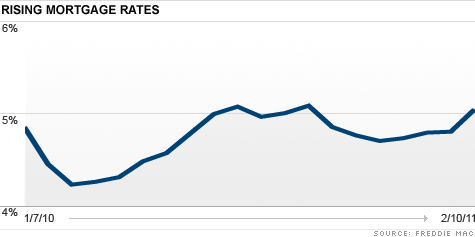By Bob Willis - Feb 23, 2011 4:00 AM PT
The number of applications for U.S. mortgages rose last week, led by more refinancing as mortgage rates fell to the lowest level since the end of January.
The Mortgage Bankers Association’s index of loan applications increased 13 percent in the week ended Feb. 18 after dropping the prior week to the lowest point since November 2008. The group’s refinancing measure jumped 18 percent and the purchase gauge rose 5.1 percent.
“Refinancing is more sensitive to fluctuations in rates†than are purchases, Paul Dales, a senior economist at Capital Economics Ltd. in Toronto, said before the report. Still, he said he expected refinancing to “remain soft†with sales at “historically depressed levels for perhaps two or three years.â€
The average rate on 30-year fixed mortgages dropped to 5 percent as turmoil in the Middle East and North Africa led investors to seek the safety of U.S. Treasury securities, which are benchmarks for some consumer loans, pulling down their yield. Still, mounting foreclosures, falling prices and 9 percent unemployment mean it will take time for demand to pick up.
The 30-year rate fell from 5.12 percent the prior week. It reached 4.21 percent in October, the lowest since the group’s records began in 1990.
At the current 30-year rate, monthly payments for each $100,000 of a loan would be $536.82, in line with the same week the prior year, when the rate was 5.04 percent.
Rates Fall
The average rate on a 15-year fixed mortgage fell to 4.28 percent from 4.34 percent.
The share of applicants seeking to refinance a loan rose to 65.7 percent from 64 percent the prior week.
The housing market is struggling to gain traction after a homebuyers’ tax credit expired last year and as more properties fall into the foreclosure pipeline. Combined sales of existing and new homes in December were at a 5.61 million annual unit pace, down from a July 2005 record of 8.53 million.
A report from the National Association of Realtors today may show existing home sales fell 1.1 percent to a 5.22 million annualized rate in January, according to economists’ estimates. Sales of previously owned homes last year totaled 4.91 million, the lowest level since 1997.
Builder Losses
Homebuilders are still posting losses. D.R. Horton Inc., the second-largest U.S. homebuilder by stock-market value, on Jan. 27 reported a fiscal first-quarter loss that was wider than analysts projected.
“I think 2011 will be a marginal, weak year in the homebuilding industry,†D.R. Horton Chief Executive Officer Donald Tomnitz said during a conference call the same day. “Given the weak macroeconomic conditions, high levels of existing homes for sale and tight mortgage availability, we remain cautious and realistic in our expectations.â€
The Washington-based Mortgage Bankers Association’s loan survey, compiled every week, covers about half of all U.S. retail residential mortgage originations.
To contact the reporter on this story: Bob Willis in Washington at bwillis@bloomberg.net
To contact the editor responsible for this story: Christopher Wellisz at cwellisz@bloomberg.net
Original article published at http://www.bloomberg.com/news/2011-02-23/u-s-mortgage-demand-rose-from-two-year-low-on-falling-rates.html

